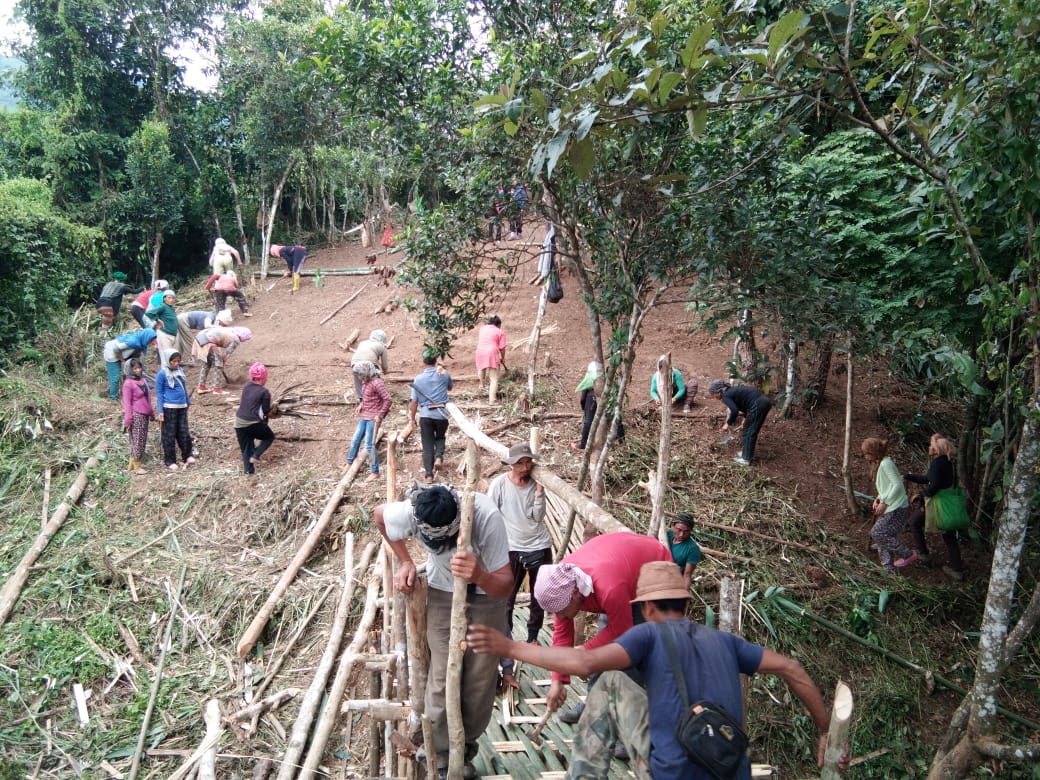দেৱীকা বৰপূজাৰী

পবিত্ৰ ৰমজান মাহৰ ২৭ দিনটোক বহু নামেৰে বিভূষিত কৰা হয়, – Laylatul Qadr বুলিও কয়। এই ৰাতিক কয় — ‘ অধিসূচনাৰ ৰাতি, শক্তিৰ ৰাতি, গুৰুত্বৰ ৰাতি, অদৃষ্টৰ ৰাতি, ইছলামিক বিশ্বাসৰ ৰাতি । এয়াই ৰাতি- যিদিনা স্বৰ্গৰ পৰা কোৰান পঠিয়াই দিয়া হৈছিল আৰু প্ৰথমবাৰৰ বাবে কোৰানৰ বাণী প্ৰফেট মহম্মদ ৰ ওচৰত প্ৰকাশ কৰা হৈছিল। মুছলমান সকলে বিশ্বাস কৰে যে, কদৰৰ ৰাতিয়ে ঈশ্বৰৰ পৰা অনাবিল আশীৰ্বাদ আৰু দয়া কঢ়িয়াই আনে। এই ৰাতিতেই পাপীক ক্ষমা কৰা হয় ।
পবিত্ৰ বুলি ভবা এই মাহটোত, দিনটোৰ ভিতৰত পাঁচবাৰ প্ৰাৰ্থনা কৰা হয় আৰু সেই কেইবিধ প্ৰাৰ্থনা বা নামাজৰ নাম হৈছে –
ৰাতিপুৱা — ফজৰ
দুপৰীয়া — জোহৰ
বিয়লি — আচৰ
সন্ধিয়া — মগৰিব
নিশা — ইছা
( মোৰ কিছু ভুল হবও পাৰে )
এনেয়েও দিনটো ৰোজা ৰখাৰ পাছত গধূলি ইফটাৰৰ সময়ত পৰিয়ালৰ লোকে ৰোজা ভাঙি খাবলৈ বহাৰ আমেজেই বেলেগ।অতীতৰ ইফটাৰৰ সময়ত চুবুৰীয়া সকল একেলগ হৈ এই অনুষ্ঠানৰ মজা লৈছিল কিন্তু আজিকালি নিজা পৰিয়াল আৰু কেতিয়াবা বন্ধু বান্ধৱ বা সম্বন্ধীয় লোকৰ লগত ইফটাৰ কৰা দেখা যায়।
সবে এ কডৰ ৰ ৰোজা মই বহু বছৰৰ পৰাই কৰি আহিছো। এই প্ৰথাৰ আৰম্ভণি হ’ল , মই মুম্বাইৰ কুৰলা ( Kurla ) ৰ মন্টেছৰী স্কুল এখনত কাম কৰিবলৈ লোৱাৰ পৰা। মোৰ সহকৰ্মী কেইবাগৰাকী মুছলমান সম্প্ৰদায়ৰ আছিল ; দুটা শ্বিফ্ট ৰ স্কুল খন ছুটী হয় আবেলি ছয় বজাৰ পাছত। যি কেইগৰাকীয়ে ৰোজা ৰাখে ঘৰলৈ গৈ ইফটাৰী কৰে কিন্তু এই বিশেষ দিনটোত আমি হিন্দু দুজনীমানেও ৰোজা ৰাখো বাবে স্কুলতে একেলগে ইফটাৰী কৰো।
প্ৰথমে আহো চেহৰি ( Sehri ) ৰ কথালৈ। চেহৰি ত খোৱা আহাৰৰ সময় সকলো ঠাইতে বেলেগ, মানে সূৰ্য্য উদয় হোৱাৰ আগতে আৰু ফজৰৰ নামাজ আৰম্ভ হোৱাৰ আগতেই চেহৰি ৰ আহাৰ খাব লাগে। খোৱাৰ আগৰ প্ৰাৰ্থনা — ” হে আল্লা ,তোমাৰ বাবেই মই আজি এই ব্ৰত ( ৰোজা ) ৰাখিবলৈ ওলাইছো, গতিকে মোৰ অতীত আৰু ভৱিষ্যতত হব লগীয়া পাপ কৰ্মৰ বাবে যেন ক্ষমা কৰা “।
ওঠৰ বছৰে স্কুলত কৰি অহাৰ দৰে, তাৰ পাছত মই স্কুল এৰাৰ পাঁচ বছৰ পাছত, আজিও মোক ৰাতিপুৱা মোৰ মৰমৰ প্ৰাক্তন সহকৰ্মী নাফিছা চুলতানাই চাৰি বজাত ফোন কৰি জগাই দিলে। মুম্বাইৰ চেহৰিৰ সময় শেষ হোৱাৰ আগতে- শোৱাৰ পৰা উঠি, গা ধুই মোৰ নিজৰ গোঁসাই থাপনাত ধূপ চাকি দি, বিশ্ববাসীৰ মঙ্গলৰ বাবে আৰু নিজৰ সন্তানৰ লগতে নাফিছাৰ পৰিয়ালৰ বাবে প্ৰাৰ্থনা জনাই একাপ ফিকা চাহৰ লগত অটছ গুৰ, কল, গাখীৰৰ খাই ললো। চেহৰিৰ শেষ সময় আছিল – ৪.৫৩..
অতীতৰ সোঁৱৰণি ……
মোৰ স্কুলৰ সময় – ৰাতিপুৱা সাত পঞ্চলিছৰ পৰা দুপৰীয়া এক বজালৈকে, গতিকে মই ঘৰলৈ গুছি আহো। সকলোৱে ভাগে ভাগে খোৱা বস্তু অনায়, মোৰ ভাগত পৰে মই নিজে বনোৱা খেজুৰৰ কেক, কেতিয়াবা তৰমুজ ।
ইফটাৰৰ সময় হোৱাৰ আগে আগে মই মোৰ ভাগৰ টোপোলা লৈ আকৌ স্কুললৈ যাওঁ।
ইফটাৰী ৰ সময় হোৱাৰ লগে লগেই আমি অজু কৰো, দোৱা কৰো, মোনাজাত কৰো।
ইয়াৰ পাছতে প্ৰাৰ্থনা জনোৱা হয়- ” হে আল্লা, তোমাৰ বাবেই মই এই ব্ৰত ( ৰোজা ) ৰাখিলো কাৰন তোমাৰ ওপৰত অসীম বিশ্বাস ৰাখো আৰু এতিয়া মই তোমাৰ বিশ্বাসতে পুষ্টিকৰ খাদ্য গ্ৰহণ কৰি মোৰ ৰোজা ভঙ্গ কৰিব খুজিছো ” ! লগে লগে আমি পানী আদা আৰু খেজুৰ খাই ৰোজাৰ অন্ত পেলাওঁ। খেজুৰত বৰ সুন্দৰ শক্তিমন্ত গুণ থকাৰ উপৰিও ইয়াত থকা পতাছিয়ামে আমাৰ পেশী আৰু স্নায়ুৰ কামকাজ চলাই থাকিবলৈ ইন্ধন যোগায়, আদাই হজম শক্তি বঢ়ায়।
ইয়াৰ পাছত আৰম্ভ হয় বিভিন্ন ধৰনৰ মুখৰোচক খাদ্য- এটাৰ পাছত এটা। কোনোৱে আনে বুট ভজাৰ লগতে পিয়াজ পাকুৰা, কোনোৱে চেৱই আৰু কাটলেট, কোনোৱে ফলৰ ৰস আৰু ৰু আফজা ইত্যাদি। সেই সময়ৰ আমাৰ প্ৰিন্সিপাল আৰু তেওঁৰ ভনীয়েক শাকাহাৰি আছিল বাবে নিৰামিষ আহাৰেই আয়োজন কৰা হৈছিল। ( মাংস নোখোৱা মুছলমান সম্প্ৰদায়ৰ লোক মই মোৰ স্কুলতেই প্ৰথম দেখিছিলো ) খোৱা সামৰি আমি ইজনীয়ে সিজনীক আকোৱালি লৈ বিদায় লওঁ। স্কুলৰ সেই ৰোজা ৰখাৰ দিনবোৰ মনলৈ আহিলেই মনটো ভাল লাগি যায়। আজি ইফটাৰীৰ সময় আছিল, সন্ধিয়া সাত বাজি এক মিনিট যোৱাত আৰু ৰাতিপুৱাৰ দৰে এইবাৰো নাফিছাই ইফটাৰীৰ সময় হ'ল বুলি ফোন কৰি সোঁৱৰাই দিলে। মই অকলে আছো বাবে আমাৰ বিল্ডিংত থকা বিউটি চেলুন খনৰ ল'ৰা ছোৱালী দুটামানে মোক সিহঁতৰ লগত ইফটাৰী কৰিবলৈ মাতিছিল কিন্তু এই ডেকা বোৰৰ মাজত মই নিমিলা অংক হৈ যাবলৈ মন নকৰি ঘৰতে যি আছিল, তাৰেই ইফটাৰী কৰিলো।
সিহঁতৰ মাজৰ জামাল আৰু নাচৰিনে মোৰ নামটো কালি সুধিছিল, মই মোৰ নাম কোৱাত কি উপাধি ,তাকো সুধিলত মই যেতিয়া কলো – বৰপূজাৰী , সিহঁতে চকু ডাঙৰ কৰি কলে – means big priest ? ময়ো হাঁহি কলো, yes I’m a brahmin with a secular heart !
আল্লা, ঈশ্বৰ, যীশু – সকলোৱে যেন সকলোকে ভালে ৰাখে, বিশ্বত যেন শান্তিৰ নিজৰা বয়। নাম প্ৰসংগ, নামাজ আদিৰ উৰ্দ্ধত যে মানৱ ধৰ্ম আছে, সেই কথাও যেন সকলো ধৰ্মীয় লোকে মনত ৰাখে আৰু কোনো প্ৰতিশোধৰ ভাব যেন মনত পুহি নাৰাখে !
আমাৰ গ্ৰন্থ সুবাস গোটৰ সকলো সদস্যও যেন কুশলে থাকে।
দেৱীকা বৰপূজাৰী
মুম্বাই । ১৯/৪/২০২৩









































